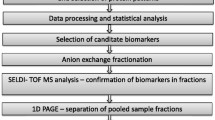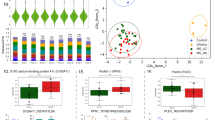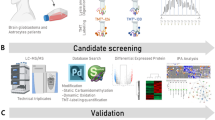Abstract
Objective
To discover serum biomarkers in astrocytoma patients for early detection of glioma and evaluation of prognosis.
Methods
A total of 140 serum samples were analyzed using the weak cation-exchange (WCX) chips. Among those, 73 were sera from astrocytoma patients, 56 from normal controls, and 11 from other brain tumors. For building a diagnosis model, the samples were randomly split into a training set and a test set with similar distribution of case and control samples. Proteomics profiles were obtained using a PBSII instrument and the data were analyzed with the accompanying software.
Results
Seven serum biomarkers were significantly deregulated in astrocytoma group comparing to the normal control group. Among them, four were up-regulated and three were down-regulated. A decision tree classification method were developed using these seven markers. A sensitivity of 84.6% and a selectivity of 84.6% were achieved to discriminate astrocytoma from normal controls. In addition, a correlation of these markers with the astrocytoma malignancy was observed.
Conclusions
Proteomics approaches such as SELDI–TOF mass spectrometry could greatly facilitate the discovery of serum biomarkers in astrocytoma. The discovered biomarkers might show great potential for early detection of astrocytoma and evaluation of prognosis for those clinical suspect astrocytoma patients. However, this need warrant further study.










Similar content being viewed by others
Abbreviations
- CV:
-
Coefficient of variance
- ExPASy:
-
Expert protein analysis system
- M/Z:
-
Mass/charge
- PBS:
-
Proteinchip® biomarker system
- SELDI–TOF MS:
-
Surface-enhanced laser desorption/ionization time of flight mass spectrometry
- SIB:
-
Swiss institute of bioinformatics
- WCX:
-
Weak cation-exchange
References
Merchant M, Weinberger SR (2000) Recent advancements in surface-enhanced laser desorption/ionization-time of flight-mass spectrometry. Electrophoresis 21:1164–1177
Wiesner A (2004) Detection of tumor markers with proteinchip technology. Curr Pharm Biotechnol 5(1):45–67
Bast RC Jr (2003) Status of tumor markers in ovarian cancer screening. J Clin Oncol 21(10 Suppl):200–205
Cazares LH, Adam BL, Ward MD, Nasim S, Schellhammer PF, Semmes OJ, Wright GLJ (2002) Normal, benign, preneoplastic, and malignant prostate cells have distinct protein expression profiles resolved by Surface Enhanced Laser Desorption/Ionization mass spectrometry. Clin Cancer Res 8(8):2541–2552
Mannes AJ, Martin BM, Yang HY, Keller JM, Lewin S, Gaiser RR, Iadarola MJ (2003) Cystatin C as a cerebrospinal fluid biomarker for pain in humans. Pain 102(3):251–256
Li J, Zhang Z, Rosenzweig J, Wang YY, Chan DW (2002) Proteomics and bioinformatics approaches for identification of serum biomarkers to detect breast cancer. Clin Chem 48:1296–1304
Srinivas PR, Verma M, Zhao Y, Srivastava S, Clark RA, Tockman MS (2002) Proteomics for cancer biomarker discovery. Clin Chem 48(8):1160–1169
Hutchens TW, Yip TT (1993) New desorption stratefies for the mass spectrometric analysis of macromolecules. Rapid Commun Mass Spectrum 7:576–580
Adam BL, Qu Y, Davis JW, Ward MD, Clements MA, Cazares LH, Semmes OJ, Schellhammer PF, Yasui Y, Feng Z, Wright GL Jr (2002) Serum protein fingerprinting coupled with a pattern-matching algorithm distinguishes prostate cancer from benigh prostate gyperplasia and healthy men. Cancer Res 62:3609–3614
Petricoin EF 3rd, Ornstein DK, Paweletz CP, Ardekani A, Hackett PS, Hitt BA, Velassco A, Trucco C, Wiegand L, Wood K, Simone CB, Levine PJ, Linehan WM, Emmert-Buck MR, Steinberg SM, Kohn EC, Liotta LA (2002) Serum proteomic patterns for detection of prostate cancer. J Nat Cancer Inst 94:1576–1578
Xiao Z, Adam BL, Cazares LH, Clements MA, Davis JW, Schellhammer PF, Dalmasso EA, Wright GL Jr (2001) Quantitation of serum prostate-specific membrane antigen by a novel protein biochip immunoassay discriminates benign from malignant prostate disease. Cancer Res 61:6029–6033
Vlahou A, Schellhammer PF, Mendrinos S, Patel K, Kondylis FI, Gong L, Nasim S, Wright GL Jr (2001) Development of a novel proteomic approach for the detection of transitional cell carcinoma of the bladder in urine. Am J Pathol 158:1491–1502
Bandera CA, Ye B, Mok SC (2003) New technologies for the identification of markers for early detection of ovarian cancer. Curr Opin Obstet Gynecol 15:51–55
Petricoin EF, Ardekani AM, Hitt BA, Levine PJ, Fusaro VA, Steinberg SM, Mills GB, Simone C, Fishman DA, Kohn EC, Liotta LA (2002) Use of proteomic patterns in serum to identify ovarian cancer. Lancet 359:572–577
Coombes KR, Fritsche HA Jr, Clarke C, Chen JN, Baggerly KA, Morris JS, Xiao LC, Hung MC, Kuerer HM (2003) Quality control and peak finding for proteomics data collected from nipple aspirate fluid by surface-enhanced laser desorption and ionization. Clin Chem 49:1615–1623
Xiao XY, Tang Y, Wei XP, He DC (2003) A preliminary analysis of non-small cell lung cancer biomarkers in serum. Biomed Environ Sci 16:140–148
Rosty C, Christa L, Kuzdzal S, Baldwin WM, Zahurak ML, Carnot F, Chan DW, Canto M, Lillemoe KD, Cameron JL, Yeo CJ, Hruban RH, Goggins M (2002) Identification of Hepatocarcinoma-Intestine-Pancreas/Pancreatitis—associated protein I as a biomarker for pancreatic ductal adenocarcinoma by protein biochip technology. Cancer Res 62:1868–1875
Pauleit D, Floeth F, Hamacher K, Riemenschneider MJ, Reifenberger G, Muller HW, Zilles K, Coenen HH, Langen KJ (2005) O-(2-[18F]fluoroethyl)-l-tyrosine PET combined with MRI improves the diagnostic assessment of cerebral gliomas. Brain 128:678–687
Author information
Authors and Affiliations
Corresponding author
Rights and permissions
About this article
Cite this article
Zhang, H., Wu, G., Tu, H. et al. Discovery of serum biomarkers in astrocytoma by SELDI–TOF MS and proteinchip technology. J Neurooncol 84, 315–323 (2007). https://doi.org/10.1007/s11060-007-9376-5
Received:
Accepted:
Published:
Issue Date:
DOI: https://doi.org/10.1007/s11060-007-9376-5




